红茶一杯话Binder
来源:互联网 发布:qq飞车神农架数据 编辑:程序博客网 时间:2024/04/27 17:24
1 什么是Binder?
简单地说,Binder是Android平台上的一种跨进程交互技术。该技术最早并不是由Google公司提出的,它的前身是Be Inc公司开发的OpenBinder,而且在Palm中也有应用。后来OpenBinder的作者Dianne Hackborn加入了Google公司,并负责Android平台的开发工作,所以把这项技术也带进了Android。
我们知道,在Android的应用层次上,基本上已经没有过去的进程概念了。然而在实现层次,它毕竟还是要建构在一个个进程之上的。实际上,在Android内部,那些支撑应用的组件往往会身处于不同的进程,那么应用的底层必然会牵涉大量的跨进程通信。为了保证通信的高效性,Android提供了Binder机制。
Binder机制具有两层含义:
1) 是一种跨进程通信手段(IPC,Inter-Process Communication)。
2) 是一种远程过程调用手段(RPC,Remote Procedure Call)。
从实现的角度来说,Binder核心被实现成一个Linux驱动程序,并运行于内核态。这样它才能具有强大的跨进程访问能力。
1.1 简述Binder的跨进程机制
为了理解Binder,我们可以先画一张最简单的跨进程通信示意图:
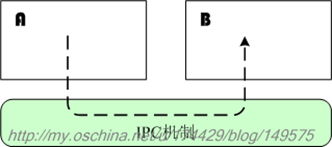
这个很容易理解,不需赘言。到了Android平台上,IPC机制就变成了Binder机制,情况类似,只不过为了便于说明问题,我们需要稍微调整一下示意图:
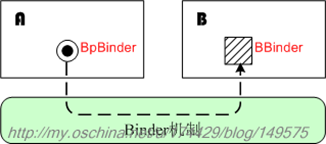
图中A侧的圆形块 ,表示“Binder代理方”,主要用于向远方发送语义,而B侧的方形块
,表示“Binder代理方”,主要用于向远方发送语义,而B侧的方形块 则表示“Binder响应方”,主要用于响应语义。需要说明的是,这种图形表示方法是我自己杜撰的,并没有正规的出处。我个人觉得这种图形非常简便,所以在分析Android架构时,会经常使用这种表示法。
则表示“Binder响应方”,主要用于响应语义。需要说明的是,这种图形表示方法是我自己杜撰的,并没有正规的出处。我个人觉得这种图形非常简便,所以在分析Android架构时,会经常使用这种表示法。
在后文中,我们可以看到,Binder代理方大概对应于C++层次的BpBinder对象,而Binder响应方则对应于BBinder对象。这两个对象在后文会详细阐述,此处不必太细究。
然而,上图的Binder代理方主要只负责了“传递信息”的工作,并没有起到“远程过程调用”的作用,如果要支持远程过程调用,我们还必须提供“接口代理方”和“接口实现体”。这样,我们的示意图就需要再调整一下,如下:

从图中可以看到,A进程并不直接和BpBinder(Binder代理)打交道,而是通过调用BpInterface(接口代理)的成员函数来完成远程调用的。此时,BpBinder已经被聚合进BpInterface了,它在BpInterface内部完成了一切跨进程的机制。另一方面,与BpInterface相对的响应端实体就是BnInterface(接口实现)了。需要注意的是,BnInterface是继承于BBinder的,它并没有采用聚合的方式来包含一个BBinder对象,所以上图中B侧的BnInterface块和BBinder块的背景图案是相同的。
这样看来,对于远程调用的客户端而言,主要搞的就是两个东西,一个是“Binder代理”,一个是“接口代理”。而服务端主要搞的则是“接口实现体”。因为binder是一种跨进程通信机制,所以还需要一个专门的管理器来为通信两端牵线搭桥,这个管理器就是Service Manager Service。不过目前我们可以先放下Service Manager Service,以后再详细研究。
2 Binder相关接口和类
Android的整个跨进程通信机制都是基于Binder的,这种机制不但会在底层使用,也会在上层使用,所以必须提供Java和C++两个层次的支持。
2.1 Java层次的binder元素
Java层次里并没有我们前文图中所表示的BpBinder、BpInterface、BBinder等较低层次的概念,取而代之的是IBinder接口、IInterface等接口。Android要求所有的Binder实体都必须实现IBinder接口,该接口的定义截选如下:
【frameworks/base/core/java/android/os/IBinder.java】
public interface IBinder { . . . . . . public String getInterfaceDescriptor() throws RemoteException; public boolean pingBinder(); public boolean isBinderAlive(); public IInterface queryLocalInterface(String descriptor); public void dump(FileDescriptor fd, String[] args) throws RemoteException; public void dumpAsync(FileDescriptor fd, String[] args) throws RemoteException; public boolean transact(int code, Parcel data, Parcel reply, int flags)throws RemoteException; public interface DeathRecipient { public void binderDied(); } public void linkToDeath(DeathRecipient recipient, int flags)throws RemoteException; public boolean unlinkToDeath(DeathRecipient recipient, int flags);}另外,不管是代理方还是实体方,都必须实现IInterface接口:
public interface IInterface{ public IBinder asBinder();}
Java层次中,与Binder相关的接口或类的继承关系如下:
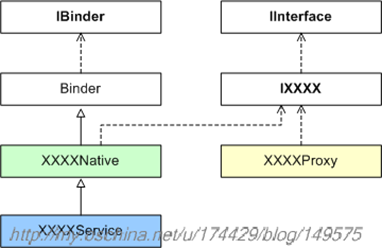
在实际使用中,我们并不需要编写上图的XXXXNative、XXXXProxy,它们会由ADT根据我们编写的aidl脚本自动生成。用户只需继承XXXXNative编写一个具体的XXXXService即可,这个XXXXService就是远程通信的服务实体类,而XXXXProxy则是其对应的代理类。
关于Java层次的binder组件,我们就先说这么多,主要是先介绍一个大概。就研究跨进程通信而言,其实质内容基本上都在C++层次,Java层次只是一个壳而已。以后我会写专文来打通Java层次和C++层次,看看它们是如何通过JNI技术关联起来的。现在我们还是把注意力集中在C++层次吧。
2.2 C++层次的binder元素
在C++层次,就能看到我们前文所说的BpBinder类和BBinder类了。这两个类都继承于IBinder,IBinder的定义截选如下:
【frameworks/native/include/binder/IBinder.h】
class IBinder : public virtual RefBase{public: . . . . . . IBinder(); virtual sp<IInterface> queryLocalInterface(const String16& descriptor); virtual const String16& getInterfaceDescriptor() const = 0; virtual bool isBinderAlive() const = 0; virtual status_t pingBinder() = 0; virtual status_t dump(int fd, const Vector<String16>& args) = 0; virtual status_t transact(uint32_t code, const Parcel& data, Parcel* reply, uint32_t flags = 0) = 0; class DeathRecipient : public virtual RefBase { public: virtual void binderDied(const wp<IBinder>& who) = 0; }; virtual status_t linkToDeath(const sp<DeathRecipient>& recipient, void* cookie = NULL, uint32_t flags = 0) = 0; virtual status_t unlinkToDeath(const wp<DeathRecipient>& recipient, void* cookie = NULL, uint32_t flags = 0, wp<DeathRecipient>* outRecipient = NULL) = 0; virtual bool checkSubclass(const void* subclassID) const; typedef void (*object_cleanup_func)(const void* id, void* obj, void* cleanupCookie); virtual void attachObject(const void* objectID, void* object, void* cleanupCookie, object_cleanup_func func) = 0; virtual void* findObject(const void* objectID) const = 0; virtual void detachObject(const void* objectID) = 0; virtual BBinder* localBinder(); virtual BpBinder* remoteBinder();protected: virtual ~IBinder();private:};
C++层次的继承关系图如下:

其中有以下几个很关键的类:
- BpBinder
- BpInterface
- BBinder
- BnInterface
它们扮演着很重要的角色。
2.2.1 BpBinder
BpBinder的定义截选如下:
class BpBinder : public IBinder{public:BpBinder(int32_t handle); inline int32_t handle() const { return mHandle; } virtual const String16& getInterfaceDescriptor() const; virtual bool isBinderAlive() const; virtual status_t pingBinder(); virtual status_t dump(int fd, const Vector<String16>& args); virtual status_t transact(uint32_t code, const Parcel& data, Parcel* reply, uint32_t flags = 0); virtual status_t linkToDeath(const sp<DeathRecipient>& recipient, void* cookie = NULL, uint32_t flags = 0); virtual status_t unlinkToDeath(const wp<DeathRecipient>& recipient, void* cookie = NULL, uint32_t flags = 0, wp<DeathRecipient>* outRecipient = NULL);. . . . . .. . . . . .
作为代理端的核心,BpBinder最重要的职责就是实现跨进程传输的传输机制,至于具体传输的是什么语义,它并不关心。我们观察它的transact()函数的参数,可以看到所有的语义都被打包成Parcel了。其他的成员函数,我们先不深究,待我们储备了足够的基础知识后,再回过头研究它们不迟。
2.2.2 BpInterface
另一个重要的类是BpInterface,它的定义如下:
template<typename INTERFACE>class BpInterface : public INTERFACE, public BpRefBase{public:BpInterface(const sp<IBinder>& remote);protected: virtual IBinder* onAsBinder();};其基类BpRefBase的定义如下:
class BpRefBase : public virtual RefBase{protected: BpRefBase(const sp<IBinder>& o); virtual ~BpRefBase(); virtual void onFirstRef(); virtual void onLastStrongRef(const void* id); virtual bool onIncStrongAttempted(uint32_t flags, const void* id); inline IBinder* remote() { return mRemote; } inline IBinder* remote() const { return mRemote; }private:BpRefBase(const BpRefBase& o); BpRefBase& operator=(const BpRefBase& o); IBinder* const mRemote; RefBase::weakref_type* mRefs; volatile int32_t mState;};BpInterface使用了模板技术,而且因为它继承了BpRefBase,所以先天上就聚合了一个mRemote成员,这个成员记录的就是前面所说的BpBinder对象啦。以后,我们还需要继承BpInterface<>实现我们自己的代理类。
在实际的代码中,我们完全可以创建多个聚合同一BpBinder对象的代理对象,这些代理对象就本质而言,对应着同一个远端binder实体。在Android框架中,常常把指向同一binder实体的多个代理称为token,这样即便这些代理分别处于不同的进程中,它们也具有了某种内在联系。这个知识点需要大家关注。
2.2.3 BBinder
Binder远程通信的目标端实体必须继承于BBinder类,该类和BpBinder相对,主要关心的只是传输方面的东西,不太关心所传输的语义。
class BBinder : public IBinder{public:BBinder(); virtual const String16& getInterfaceDescriptor() const; virtual bool isBinderAlive() const; virtual status_t pingBinder(); virtual status_t dump(int fd, const Vector<String16>& args); virtual status_t transact(uint32_t code, const Parcel& data, Parcel* reply, uint32_t flags = 0); virtual status_t linkToDeath(const sp<DeathRecipient>& recipient, void* cookie = NULL, uint32_t flags = 0); virtual status_t unlinkToDeath(const wp<DeathRecipient>& recipient, void* cookie = NULL, uint32_t flags = 0, wp<DeathRecipient>* outRecipient = NULL); virtual void attachObject(const void* objectID, void* object, void* cleanupCookie, object_cleanup_func func); virtual void* findObject(const void* objectID) const; virtual void detachObject(const void* objectID); virtual BBinder* localBinder();protected: virtual ~BBinder(); virtual status_t onTransact(uint32_t code, const Parcel& data, Parcel* reply, uint32_t flags = 0);private: BBinder(const BBinder& o); BBinder& operator=(const BBinder& o); class Extras; Extras* mExtras; void* mReserved0;};
我们目前只需关心上面的transact()成员函数,其他函数留待以后再分析。transact函数的代码如下:
【frameworks/native/libs/binder/Binder.cpp】
status_t BBinder::transact(uint32_t code, const Parcel& data, Parcel* reply, uint32_t flags){ data.setDataPosition(0); status_t err = NO_ERROR; switch (code) { case PING_TRANSACTION: reply->writeInt32(pingBinder()); break; default: err = onTransact(code, data, reply, flags); break; } if (reply != NULL) { reply->setDataPosition(0); } return err;}看到了吗,transact()内部会调用onTransact(),从而走到用户所定义的子类的onTransact()里。这个onTransact()的一大作用就是解析经由Binder机制传过来的语义了。
2.2.4 BnInterface
远程通信目标端的另一个重要类是BnInterface<>,它是与BpInterface<>相对应的模板类,比较关心传输的语义。一般情况下,服务端并不直接使用BnInterface<>,而是使用它的某个子类。为此,我们需要编写一个新的BnXXX子类,并重载它的onTransact()成员函数。
BnInterface<>的定义如下:
template<typename INTERFACE>class BnInterface : public INTERFACE, public BBinder{public: virtual sp<IInterface> queryLocalInterface(const String16& _descriptor); virtual const String16& getInterfaceDescriptor() const;protected: virtual IBinder* onAsBinder();};如上所示,BnInterface<>继承于BBinder,但它并没有实现一个默认的onTransact()成员函数,所以在远程通信时,前文所说的BBinder::transact()调用的onTransact()应该就是BnInterface<>的某个子类的onTransact()成员函数。
2.3 几个重要的C++宏或模板
为了便于编写新的接口和类,Android在C++层次提供了几个重要的宏和模板,比如我们在IInterface.h文件中,可以看到DECLARE_META_INTERFACE、IMPLEMENT_META_INTERFACE的定义。
2.3.1 DECLARE_META_INTERFACE()
DECLARE_META_INTERFACE()的定义如下:
#define DECLARE_META_INTERFACE(INTERFACE) \ static const android::String16 descriptor; \ static android::sp<I##INTERFACE> asInterface( \ const android::sp<android::IBinder>& obj); \ virtual const android::String16& getInterfaceDescriptor() const; \ I##INTERFACE(); \ virtual ~I##INTERFACE(); \
我们举个实际的例子,来说明如何使用这个宏:

上例中ICamera内部使用了DECLARE_META_INTERFACE(Camera),我们把宏展开后,可以看到ICamera类的定义相当于:
class ICamera: public IInterface{public:static const android::String16 descriptor;static android::sp<ICamera> asInterface( const android::sp<android::IBinder>& obj);virtual const android::String16& getInterfaceDescriptor() const;ICamera();virtual ~ICamera();virtual void disconnect() = 0;. . . . . .宏展开的部分就是中间那5行代码,其中最关键的就是asInterface()函数了,这个函数将承担把BpBinder打包成BpInterface的职责。
2.3.2 IMPLEMENT_META_INTERFACE()
与DECLARE_META_INTERFACE相对的就是IMPLEMENT_META_INTERFACE宏。它的定义如下:
#define IMPLEMENT_META_INTERFACE(INTERFACE, NAME) \ const android::String16 I##INTERFACE::descriptor(NAME); \ const android::String16& \ I##INTERFACE::getInterfaceDescriptor() const { \ return I##INTERFACE::descriptor; \ } \ android::sp<I##INTERFACE> I##INTERFACE::asInterface( \ const android::sp<android::IBinder>& obj) \ { \ android::sp<I##INTERFACE> intr; \ if (obj != NULL) { \ intr = static_cast<I##INTERFACE*>( \ obj->queryLocalInterface( \ I##INTERFACE::descriptor).get()); \ if (intr == NULL) { \ intr = new Bp##INTERFACE(obj); \ } \ } \ return intr; \ } \ I##INTERFACE::I##INTERFACE() { } \ I##INTERFACE::~I##INTERFACE() { } \其中,实现了关键的asInterface()函数。
实际使用IMPLEMENT_META_INTERFACE时,我们只需把它简单地写在binder实体所处的cpp文件中即可,举例如下:
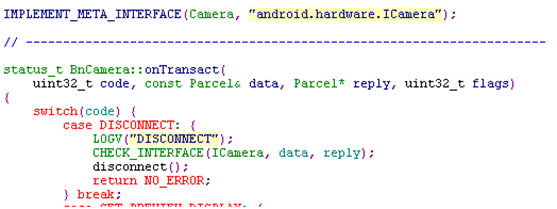
其中的IMPLEMENT_META_INTERFACE(Camera, “android.hardware.ICamera”);一句相当于以下这段代码:
const android::String16 ICamera::descriptor(“android.hardware.ICamera”);const android::String16& ICamera::getInterfaceDescriptor() const {return ICamera::descriptor;}android::sp<ICamera> ICamera::asInterface(const android::sp<android::IBinder>& obj){android::sp<ICamera > intr;if (obj != NULL) {intr = static_cast<ICamera*>(obj->queryLocalInterface(ICamera::descriptor).get()); if (intr == NULL) { intr = new BpCamera(obj); }} return intr;}ICamera::ICamera() { }ICamera::~ICamera () { }看来,其中重点实现了asInterface()成员函数。请注意,asInterface()函数中会先尝试调用queryLocalInterface()来获取intr。此时,如果asInterface()的obj参数是个代理对象(BpBinder),那么intr = static_cast<ICamera*>(obj->queryLocalInterface(...)一句得到的intr基本上就是NULL啦。这是因为除非用户编写的代理类重载queryLocalInterface()函数,否则只会以默认函数为准。而IBinder类中的默认queryLocalInterface()函数如下:
【frameworks/native/libs/binder/Binder.cpp】
sp<IInterface> IBinder::queryLocalInterface(const String16& descriptor){ return NULL;}另一方面,如果obj参数是个实现体对象(BnInterface对象)的话,那么queryLocalInterface()函数的默认返回值就是实体对象的this指针了,代码如下:
【frameworks/native/include/binder/IInterface.h】
template<typename INTERFACE>inline sp<IInterface> BnInterface<INTERFACE>::queryLocalInterface(const String16& _descriptor){ if (_descriptor == INTERFACE::descriptor) return this; return NULL;}
在我们所举的Camera例子中,我们要研究的是如何将BpBinder转成BpInterface,所以现在我们只阐述obj参数为BpBinder的情况。此时asInterface()函数中obj->queryLocalInterface()的返回值为NULL,于是asInterface()会走到new BpCamera(obj)一句,这一句是最关键的一句。我们知道,BpCamera继承于BpInterface<ICamera>,所以此时所创建的BpCamera对象正是可被App使用的BpInterface代理对象。
BpCamera的定义如下:
class BpCamera: public BpInterface<ICamera>{public: BpCamera(const sp<IBinder>& impl) : BpInterface<ICamera>(impl) { } // disconnect from camera service void disconnect() { LOGV("disconnect"); Parcel data, reply; data.writeInterfaceToken(ICamera::getInterfaceDescriptor()); remote()->transact(DISCONNECT, data, &reply); }. . . . . .至此,IMPLEMENT_META_INTERFACE宏和asInterface()函数的关系就分析完毕了。
2.3.3 interface_cast
不过,我们经常使用的其实并不是asInterface()函数,而是interface_cast(),它简单包装了asInterface():
template<typename INTERFACE>inline sp<INTERFACE> interface_cast(const sp<IBinder>& obj){ return INTERFACE::asInterface(obj);}
以上就是关于C++层次中一些binder元素的介绍,下面我们再进一步分析其他细节。
3 ProcessState
前文我们已经提到过,在Android的上层架构中,已经大幅度地弱化了进程的概念。应用程序员能看到的主要是activity、service、content provider等概念,再也找不到以前熟悉的main()函数了。然而,底层程序(C++层次)毕竟还是得跑在一个个进程之上,现在我们就来看底层进程是如何运用Binder机制来完成跨进程通信的。
在每个进程中,会有一个全局的ProcessState对象。这个很容易理解,ProcessState的字面意思不就是“进程状态”吗,当然应该是每个进程一个ProcessState。ProcessState的定义位于frameworks/native/include/binder/ProcessState.h中,我们只截选其中的一部分:
class ProcessState : public virtual RefBase{public: static sp<ProcessState> self(); . . . . . . void startThreadPool(); . . . . . . void spawnPooledThread(bool isMain); status_t setThreadPoolMaxThreadCount(size_t maxThreads);private: friend class IPCThreadState; . . . . . . struct handle_entry { IBinder* binder; RefBase::weakref_type* refs; }; handle_entry* lookupHandleLocked(int32_t handle); int mDriverFD; void* mVMStart; mutable Mutex mLock; // protects everything below. Vector<handle_entry> mHandleToObject; . . . . . . KeyedVector<String16, sp<IBinder> > mContexts; . . . . . .};我们知道,Binder内核被设计成一个驱动程序,所以ProcessState里专门搞了个mDriverFD域,来记录binder驱动对应的句柄值,以便随时和binder驱动通信。ProcessState对象采用了典型的单例模式,在一个应用进程中,只会有唯一的一个ProcessState对象,它将被进程中的多个线程共用,因此每个进程里的线程其实是共用所打开的那个驱动句柄(mDriverFD)的,示意图如下:

每个进程基本上都是这样的结构,组合起来的示意图就是:
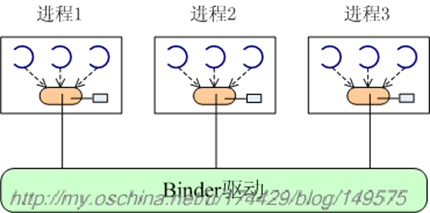
我们常见的使用ProcessState的代码如下:
int main(int argc, char** argv){ sp<ProcessState> proc(ProcessState::self()); . . . . . . . . . . . . ProcessState::self()->startThreadPool(); IPCThreadState::self()->joinThreadPool();}因为ProcessState采用的是单例模式,所以它的构造函数是private的,我们只能通过调用ProcessState::self()来获取进程中唯一的一个ProcessState对象。self()函数的代码如下:
sp<ProcessState> ProcessState::self(){ Mutex::Autolock _l(gProcessMutex); if (gProcess != NULL) { return gProcess; } gProcess = new ProcessState; return gProcess;}
ProcessState对象构造之时,就会打开binder驱动:
ProcessState::ProcessState() : mDriverFD(open_driver()) // 打开binder驱动。 , mVMStart(MAP_FAILED) , mManagesContexts(false) , mBinderContextCheckFunc(NULL) , mBinderContextUserData(NULL) , mThreadPoolStarted(false) , mThreadPoolSeq(1){ . . . . . . mVMStart = mmap(0, BINDER_VM_SIZE, PROT_READ, MAP_PRIVATE | MAP_NORESERVE, mDriverFD, 0); . . . . . . }注意上面那句mDriverFD(open_driver()),其中的open_driver()就负责打开“/dev/binder”驱动:
static int open_driver(){ int fd = open("/dev/binder", O_RDWR); . . . . . . status_t result = ioctl(fd, BINDER_VERSION, &vers); . . . . . . size_t maxThreads = 15; result = ioctl(fd, BINDER_SET_MAX_THREADS, &maxThreads); . . . . . . return fd;}
ProcessState中另一个比较有意思的域是mHandleToObject:
Vector<handle_entry> mHandleToObject;它是本进程中记录所有BpBinder的向量表噢,非常重要。我们前文已经说过,BpBinder是代理端的核心,现在终于看到它的藏身之处了。在Binder架构中,应用进程是通过“binder句柄”来找到对应的BpBinder的。从这张向量表中我们可以看到,那个句柄值其实对应着这个向量表的下标。这张表的子项类型为handle_entry,定义如下:
struct handle_entry { IBinder* binder; RefBase::weakref_type* refs;};其中的binder域,记录的就是BpBinder对象。
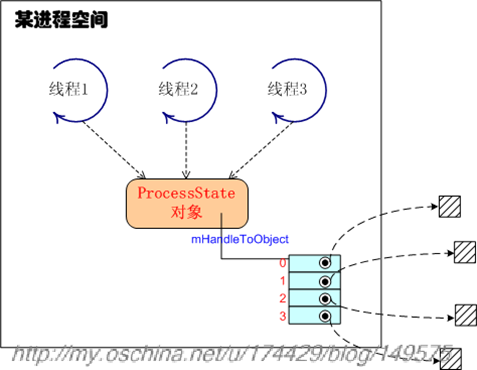
Ok,有关Binder的初步知识,我们就先说这么多。我也不想一下子把所有的信息都塞到一篇文章中,所以打算把更多技术细节安排到其他文章中阐述,呵呵,这需要一点儿时间。
原文地址:https://my.oschina.net/youranhongcha/blog/149575
- 红茶一杯话Binder
- 红茶一杯话Binder
- 红茶一杯话Binder(经典Binder解析)
- 红茶一杯话Binder(初始篇)
- 红茶一杯话Binder(ServiceManager篇)
- 红茶一杯话Binder(ServiceManager篇)
- 红茶一杯话Binder(ServiceManager篇)
- 红茶一杯话Binder(初始篇)
- 红茶一杯话Binder(ServiceManager篇)
- 红茶一杯话Binder(ServiceManager篇)
- 红茶一杯话Binder(初始篇)
- 红茶一杯话Binder(传输机制篇_上)
- 红茶一杯话Binder(传输机制篇_中)
- 红茶一杯话Binder(传输机制篇_下)
- 红茶一杯话Binder(传输机制篇_上)
- 红茶一杯话Binder(传输机制篇_下)
- 红茶一杯话Binder(传输机制篇_中)
- 红茶一杯话Binder(传输机制篇_上)
- Revit开发之可停靠窗口应用
- Android TextView 部分字符高亮
- CentOS6.5使用yum命令方便快捷安装Nginx
- Solr学习 DIH增量、定时导入并检索数据
- 面试题--计算机网络
- 红茶一杯话Binder
- 【笔记】HLS技术架构
- PHP微信网页版功能分析
- android自定义添加控件
- React-Native手势识别(曲线比较)
- 基于JS模块化现状谈谈选择ES6模块的原因
- MySQL执行计划解读
- Error:warning: Ignoring InnerClasses attribute for an anonymous inner class
- Linux压缩命令2


